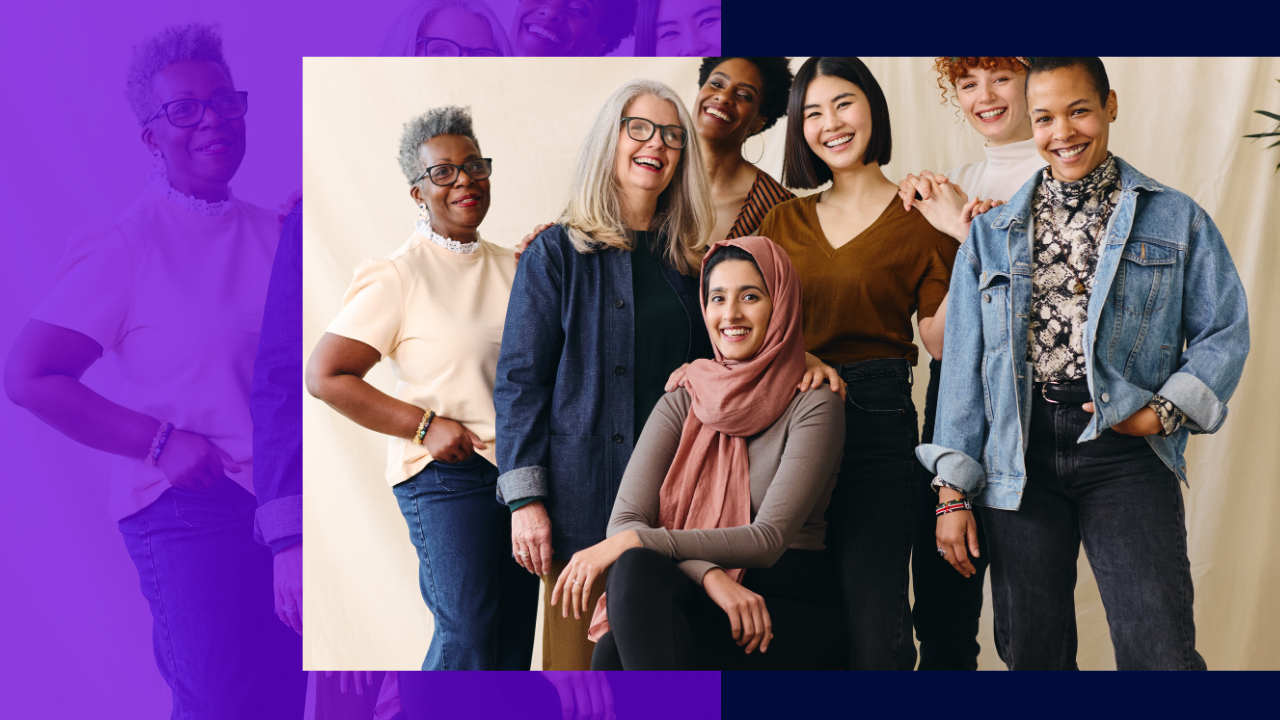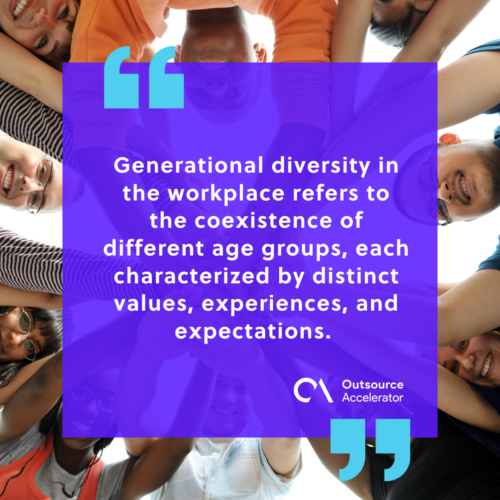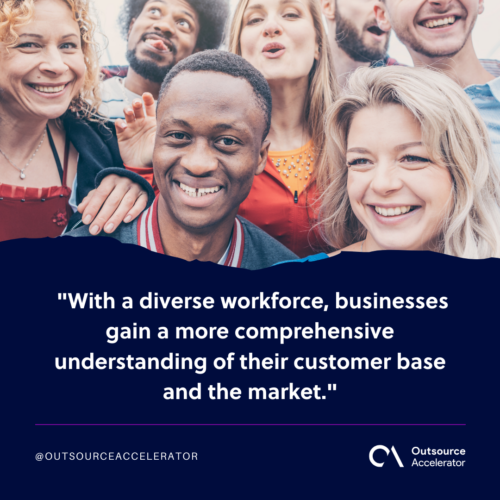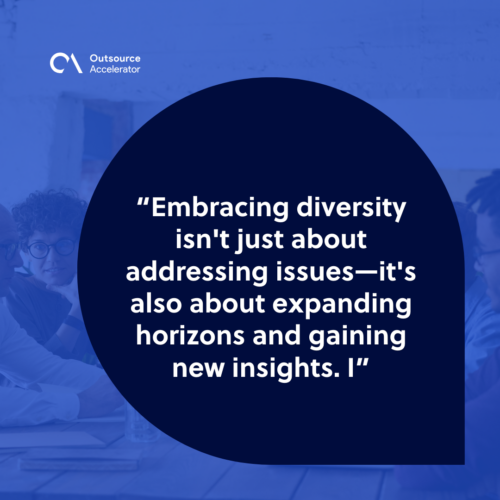Understanding generational diversity in the workplace

Today’s workplace includes people from different generations, each with their own views, abilities, and attitudes.
Businesses must grasp this generational diversity to make the most of their workforce.
In this article, we’ll examine the concept of generational diversity, why it’s important, and how to handle it effectively.
What is generational diversity?
Generational diversity in the workplace refers to the coexistence of different age groups, each characterized by distinct values, experiences, and expectations.
The primary generations in today’s workforce include:
- Baby Boomers
- Generation X
- Millennials
- Generation Z
According to Purdue Global, 25% of Baby Boomers, 33% of Generation X, 35% of Millennials, and 5% of Generation Z are in the US workforce. These age groups bring many perspectives and skills.

Benefits of generational diversity
Generational diversity brings a wealth of advantages. Let’s delve into these benefits:
Innovation and creativity
One of the most exciting aspects of generational diversity is the potential for innovation and creativity.
When individuals from various generations come together, their unique life experiences, perspectives, and problem-solving approaches collide.
This collision often sparks innovative ideas and fresh solutions.
Knowledge sharing
Generational diversity in the workplace promotes the exchange of knowledge. The older generation, often called the Baby Boomers, possesses a wealth of institutional wisdom and historical context.
The younger generations, such as Millennials and Generation Z, offer fresh insights and cutting-edge knowledge about emerging trends and technologies.
This knowledge transfer is like passing wisdom from one generation to the next.
Skill diversity
Each generation tends to bring a unique set of skills to the workplace.
Baby Boomers may excel in traditional business practices and interpersonal skills. At the same time, younger generations, like Millennials and Gen Z, are typically tech-savvy and quick to adapt to new tools and technologies.
This skill diversity resembles a toolkit with various instruments, each serving a different purpose. Combined, it creates a comprehensive and adaptable set of skills, ready to tackle any challenge.
Adaptability
The ability to adapt to change is a critical skill in today’s business world.
Younger generations, growing up in an era of rapid technological advancements, tend to embrace change more readily. On the other hand, older generations offer stability and resilience, like a ship’s anchor.
Customer and market understanding
With a diverse workforce, businesses gain a more comprehensive understanding of their customer base and the market.
Different generations bring their unique perspectives and experiences. Companies can effectively tailor their products and services to meet a diverse demographic’s varying needs and preferences.

Challenges of generational diversity
While generational diversity offers significant advantages, it also presents its own set of challenges.
Let’s explore these obstacles that companies and business owners often encounter:
Communication differences
One of the primary challenges of generational diversity is the differences in communication styles.
Each generation has its unique way of conveying ideas and information, often shaped by their time’s technology and cultural norms. Baby Boomers prefer face-to-face conversations, while younger generations lean towards digital communication channels.
Conflict and misunderstanding
Generational diversity can sometimes lead to conflicts and misunderstandings in the workplace. Inharmony may be rooted to differences in values, work habits, or communication styles.
For instance, younger employees may perceive older colleagues as resistant to change, while older employees might view younger ones as lacking respect for established traditions.
Technology gaps
The pace of technological advancement varies among generations. Younger generations tend to adapt quickly to new technologies, while older generations may struggle to keep up with the latest digital tools.
A technology gap can lead to disparities in the workplace.
Resistance to change
Resistance to change is a challenge that often arises in the context of generational diversity.
Some employees, particularly those from older generations, may be apprehensive about implementing new processes or technologies.
Stereotyping
Stereotyping is an issue that can affect employees from different generations. Individuals may be unfairly labeled or subjected to negative stereotypes based on age.
Best practices for maintaining generational diversity
Maintaining and harnessing the power of generational diversity in the workplace requires a set of best practices.
Create an inclusive culture
Fostering an inclusive culture is essential. It promotes an environment where every generation feels valued and respected.
An inclusive culture encourages open dialogue, collaborative problem-solving, and a sense of belonging for all employees, regardless of age.
Diversity training
Implementing diversity training programs is a proactive step toward managing generational diversity effectively.
These programs educate employees on the importance of generational diversity and provide them with the tools to navigate intergenerational dynamics successfully.
Mentorship and reverse mentoring
Establishing mentorship programs spanning generations is a powerful way to bridge the generational gap. These programs allow employees from different age groups to learn from one another.
Younger employees can mentor older colleagues on tech-related matters, while older employees can offer guidance based on their experience.
Flexible work arrangements
Offering flexible work arrangements is another strategy to accommodate various generations’ different needs and preferences. This could include remote work, flexible hours, or compressed workweeks.
Flexibility allows individuals to balance work and life according to their generational and personal needs.
Open communication channels
Promote open and transparent communication within the organization. Encourage employees to express their thoughts, concerns, and ideas without fear of judgment.
Open communication fosters a culture of respect and understanding among all generations.
It’s similar to establishing a platform where individuals can express their thoughts and feel acknowledged, fostering a place for productive conversations.
Generational diversity as a learning opportunity
Beyond the challenges and solutions, it’s important to view generational diversity as a learning opportunity.
Embracing diversity isn’t just about addressing issues—it’s also about expanding horizons and gaining new insights. It’s an opportunity for personal and professional growth.

Consider it as a journey where you explore different cultures and traditions, broadening your horizons and enriching your life.
Incorporating these best practices can lead to a harmonious and productive workplace where generational diversity is accepted and celebrated.
It’s a path toward creating a dynamic and inclusive environment where the strengths of each generation are harnessed to drive the organization forward.







 Independent
Independent




